When you go for a “Day at the Races’ you get a wonderful experience. There is the hustle and bustle of the crowds; the excitement of taking a bet with the bookies; the tense atmosphere before the race among the trainers, jockeys and owners; the parade of the horses; and watching the horses going hell for leather. There is also the post race celebrations, the champagne corking and the money won and lost and what might have been.
But there is another side to the ‘Day at the Races’. The work that is involved in preparing the punter having a good day out often goes unnoticed. I visited one such racecourse in County Kildare and caught up with the track manager at Naas racecourse, Roy Butler, to get an insight into what is involved in looking after a race track and preparing it for a race meeting.
Naas racecourse is one of three racing tracks located in County Kildare, a county renown for world class horse breeding. The other two tracks are The Curragh and Punchestown. The building of Naas racecourse began one hundred years ago, in January 1921. The formation of Naas Races Company took place the following year with their first race meeting taking place in June 1924. Over the years Naas racecourse has progressed as one of Europe’s foremost horse racing establishments with state of the art facilities.

The racecourse at Naas
The racetrack itself is left-handed. The track runs for around a mile and a half, with the home straight comprising of a four furlong (half mile) uphill home run, resembling the same incline and stretch as Cheltenham. Because of this, Naas is often referred to as the mini Cheltenham and many winners at Naas go on to do very well at Cheltenham. There are twenty race meetings each year, comprising both flat and hurdle races. This is made up of around twelve flat races and eight jump races. The first flat race of the year in Ireland, begins at Naas, in March, as does the last flat race of the season, taking place at the end of October.
Track manager, Roy Butler comes from a greenkeeping background, having worked in Athy Golf Club as Head greenkeeper there for twelve years. In 2018, after the retirement of Paddy Timmons, who was track foreman at Naas for forty seven years, Roy was offered the position of track foreman. At first he was reluctant to take up the offer but decided, in the end, to take the plunge of sidestepping into a different career. I say sidestepping as the new job still involved turf maintenance but at a completely different sport. Maintaining a golf course and the needs of its member’s is a lot different than managing a racetrack where horses trample over your turf.
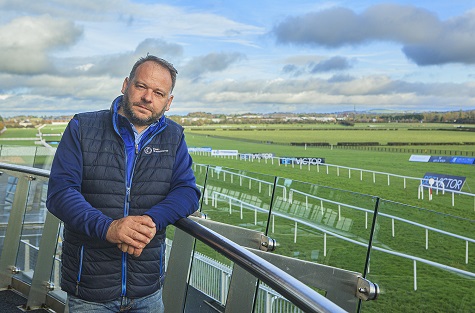
Roy Butler, the track foreman at Naas Racecourse
Three years later, I’m happy to report, that Roy has had no regrets. “I love the job here at Naas. There is a great atmosphere here among the workforce. The management here are savagely progressive and respect the professionalism of each of the departments, whether it is the catering section, the cleaners or my own department, they appreciate the work we do” said Roy. Since taking up the role as track foreman, €200,000 worth of machinery has been invested to maintain the track. Roy has already made an impression at Naas. In 2019, just a year after taking up the job, Naas racecourse was voted Racecourse of the Year. This was the first time that Naas received such an award. The Racecourse of the Year award did not take place in 2020, due to COVID-19.
The lockdown didn’t affect the work schedule at Naas racetrack as race meetings were still allowed to take place in Ireland, albeit behind closed doors. No member of the the public could attend, not even the horse owners, only the jockeys, trainers and grooms (one groom/horse). However, this didn’t lighten the work load for Roy and his team. The damage and repairs to the turf was just as plentiful as before and after the lockdowns.
The public are allowed to walk around the track on non meeting days. There is a tarmac pathway around the track to facilitate this. Walking was still allowed during lockdown, which was very much appreciated by the locals.
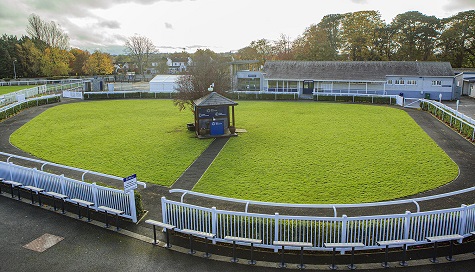
The parade ring and winners enclosure
The turf maintenance involves the same principals as that on a golf course, i.e. scarifying, vertidraining, overseeding, and irrigating when necessary. There is even an agronomist that Roy gets advice from. However, one notable difference between maintaing a golf course over a race track is that presentation is to the fore for a golf course while horse safety is paramount when maintaining a race track. The turf is mown at four inches in Summer, increasing to five inches in Winter. In times of drought, the race track is irrigated using a Briggs irrigation system. This was installed in 2016, costing €600,000 at the time and can provide 3mm – 25mm of water per day over the entire track. The water used is sourced from their own well and stored in a man made reservoir, located on the perimeter of the racecourse. During the drought of 2018, the reservoir came close to running dry, so, in the event of future droughts Roy hopes to double the capacity of the reservoir.
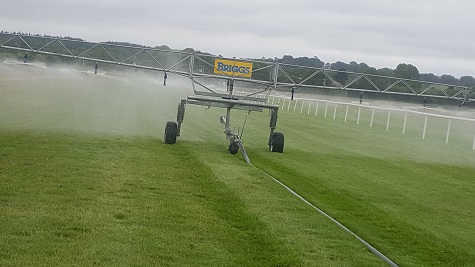
The irrigation system in full flow. Photo courtesy Roy Butler
Roy has five full time staff but this increases to twelve after each race meeting when track repairs need to be carried out. Up to 130 horses can run at any given meeting. The divots created after each race meeting must be quickly repaired prior to the next event so as to ensure the safety of the horses. Any injury to these top class horses will not only prove costly for the owner but a horse falling can also lead to injury to the jockey, so there is a lot of responsibility put on Roy and his team.
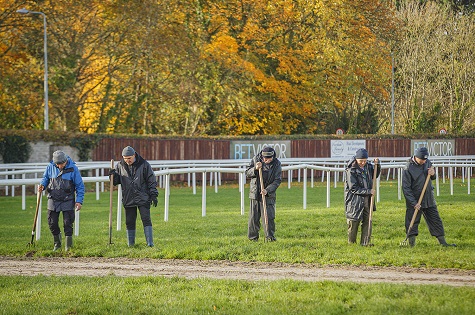
Extra staff are brought in to repair divots after a race meeting
Not long after Roy was employed he was concerned about the stretch of ground from the parade ring to the starting point. This section of turf was getting a lot of wear and tear so he suggested to management of installing a sand/fibre canter down to reduce the damage being caused to the turf. They agreed to this and installed the canter down to the top section. It has proved succssful and plans are in place to continue it down to the starting point.
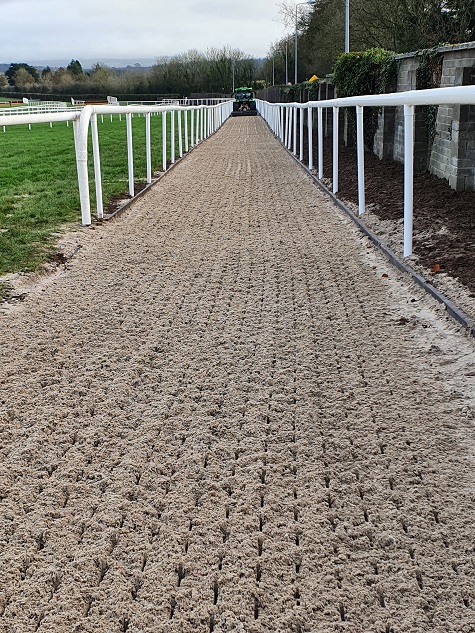
The addition of the canter down has reduced part of the track from wear and tear. Photo courtesy Roy Butler
Not only is Roy responsible for the maintenance of the turf on the racecourse, which is on a site covering almost 150 acres, but he must also ensure that the stables are kept in tip top condition. Since the equine flu occured, stricter rules have been put in place to keep the stables virus free. This involves completely removing the old litter; hoovering the stable floor; power washing and sanitising the stable before fresh shavings are placed in each stable. This involves a lot of work, especially when there are 150 stables, the most at any racecourse in Ireland. It is important to keep up with this routine as, from time to time, random visits are done by the Irish Equine Centre to check that the stables are up to standard and are free of viruses and fungi.

There are 150 stables at Naas, the most at any racecourse in Ireland
There are other subtle differences maintaining a race track. “We need to repair the fences for both the hurdles and steeplechase courses” said Roy. “The steeplechase fences are more permanent and demand a lot more maintenance. They consist of birch and evergreen tree branches, such as Leylandii, which need to be replaced and tied in regularly while the birch branches are kept in shape just like a hedge. These fences need to be moved from time to time so as to spread wear and tear on the turf, just like you do when moving tee markers on a golf course” continued Roy.
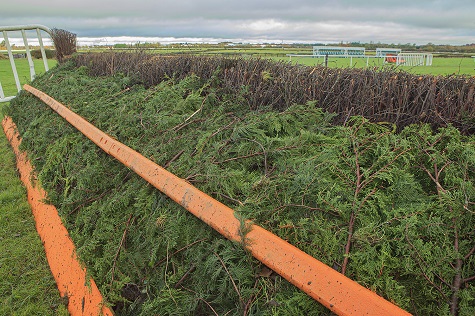
The steeplechase fences require a lot of maintenance
On the morning of a race meeting Roy inspects the condition of the track , along with the Clerk of the Course and the General Manager. Their assesments are sent to Horse Racing Ireland (HRI) who then publish it so that trainers know what condition the track is in. Each trainer, on foot of this report, will decide to enter a race, or not. During the races Roy must be on hand to deal with any emergencies that may arise such as horses or jockeys falling. He has screens at hand should the need arise. Roy even has the authority, with the coordination of the Clerk of the Course, to stop a race in certain situations.
Preparing for a race meeting not only involves keeping the turf in good condition. Other work involves making sure the running rails are straight, looking after the flower beds, hanging baskets and maintaining the parade ring to name but a few.
After a race meeting the track suffers from a lot of wear and tear so the rails need to be relocated before the next meeting. This involves lifting the rails and moving them two or three meters to the left or right. This could take four or five days to complete. Because the race track is one and a half miles it means that three miles of fencing need to be moved. Generally, there is a two or three week gap between meetings, which gives the team enough time to carry out the repairs. However, on occassions there may only be seven days to get the track back in ship shape condition.

Assistant track foreman Declan Harrington and John Gorey relocating the rails
I never realised how much work goes into maintaining a race track. The next time you go to Naas for a ‘Day at the Races’ or see it on TV, you should give Roy and his crew a thought and think of the work they have put in behind the scenes to provide you with a wonderful day out.